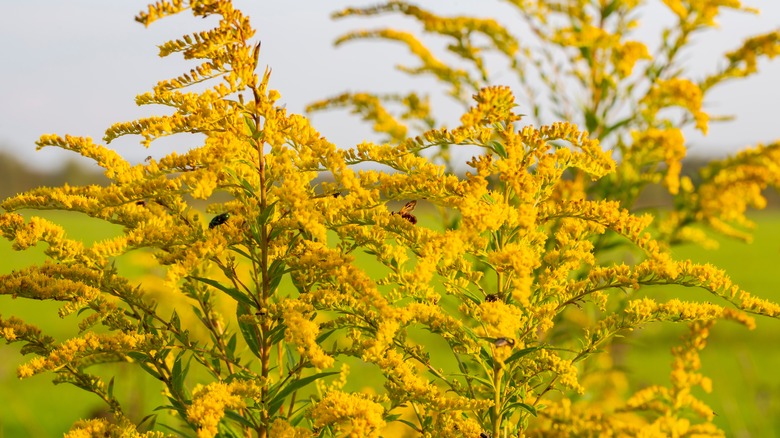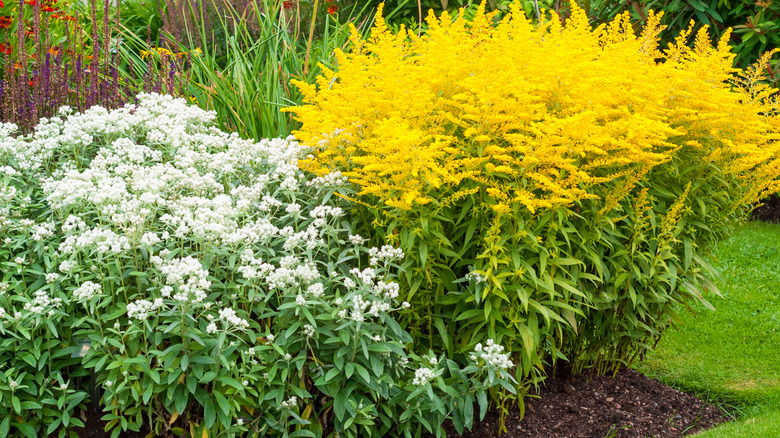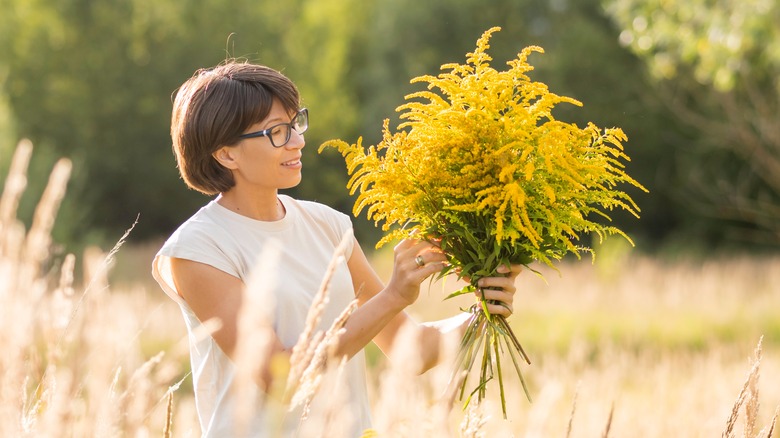The Gorgeous Perennial You Could Be Adding To Your Floral Arrangements
If you are searching for the perfect addition to your late-season garden floral display, why not consider adding a Solidago rugosa? Also known as the goldenrod, these herbaceous perennials are native wildflowers that grow naturally in sunny open meadows and prairies. They explode into a stunning display, with sprays of tiny golden blossoms reaching up to 18 inches long. The bright yellow flowers mark the end of summer and the beginning of fall, painting your garden with flashes of gold that will blend beautifully with the emerging warm oranges, browns, and reds of the new season.
The goldenrod is a gorgeous perennial you can also add to your floral arrangements. This plant will not only brighten up your garden, it will provide the perfect opportunity to harvest flowers for your house to enjoy as bouquets in vases. Alternatively, you can dry them out to decorate your home in true primitive fall style with impressive wreaths for your doors and garlands for the mantelpiece. You can also harvest it for its medicinal properties. In fact, it was traditionally used to heal wounds.
How to grow Goldenrod in your garden
This beautiful perennial blooms from late summer to mid-fall and will attract many beneficial insects and pollinators into your garden, so it's definitely a good one to have if you grow many other plants that will benefit from bees, butterflies, and predatory insects. To grow goldenrod you will need a well-draining substrate, like sandy or rocky soil, and full sun. It's helpful to know which species of the plant you have as some prefer totally different growing conditions and environments — from shady woodlands to boggy or even salty coastal areas. Go for a species that is native to your local area. If you're looking for a plant that is less invasive for a tidier garden, you'll prefer the clump-forming type, as opposed to the ones that grow from rhizomes, which spread more easily and can get rather wild-looking.
To plant, you can sow the seeds directly outside in your garden on the soil surface so they have access to enough sunlight to germinate, with plenty of space in between for growth. This is especially important when planting near other plants, as you don't want them to take over nutrients and overcrowd their neighbors. Sow your seeds in the late spring or early fall — no fertilizing needed. Any later, and they will begin to germinate the following spring when temperatures warm up.
How to add Goldenrod to your floral arrangements
Florists love goldenrod as a common filler flower for crafting stunning fall bouquets. They are also very popular amongst dried flower artists. You can easily create your own floral arrangements by adding interest with splashes of bright yellow from the goldenrod. Try creating a unique tiered design with a layer of short goldenrod stems in the foreground of your display. Or use the golden stems throughout your bouquet to add color and provide balance. Start by adding a bunch of freshly cut goldenrods to your vase and then strategically position your other chosen flowers until you're happy. You can add any colorful fall blooms — try some cosmos, purple coneflowers, lilies, and late roses.
For dried flower arrangements, wreaths, and garlands, simply hang your goldenrod in bunches to air dry. To keep the form of the blooms as they dry, you can try using the sand method, which offers more support during the drying time, giving the dried flowers a more life-like effect. A warm, dry room will help dry them faster and preserve more vibrant colors too. For sand-drying, pour a ½-inch of sand into a box and place the flowers on top. Then slowly pour sand so it flows gently around, under and then over — never pour the sand directly onto the flowers. Don't forget to label and date the box, and leave for up to 3 weeks for beautiful dried goldenrod flowers.


